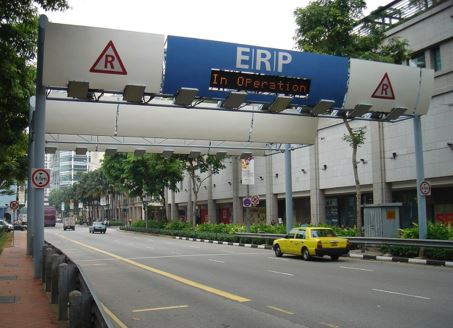Congestion pricing is a transport demand management measure adopted to reduce the impacts of traffic congestion on cities. It links the externalities of road transport directly to the travellers who produce them. They are implemented through the definition of tolling systems to influence short-term demand choices, forcing travellers to switch to sustainable transport modes and low impact road routes.
Congestion charges can be introduced either in a defined geographical area or on a road network, leading to two types of charging: area and network. The former can lead to two configurations of tolls, the zone toll and the cordon toll. In the first, the motorist pays a fixed rate to drive in the zone, regardless of the route. In the latter, a number of points delimit the toll zone. Each crossing of these points triggers a payment. In network pricing, the motorist pays to use a facility.

ERP Gantry at North Bridge Road, next to PARCO Bugis Junction
While reducing congestion is one of the objectives that congestion charging can help to achieve by regulating urban car traffic, it can achieve other objectives, which may or may not be cumulative:
- generate revenue: here they have a function of financing transport systems,
- improve the quality of urban life and in particular air quality: they have a function of reducing environmental nuisance.
An urban toll is defined by its numerous application methods: the perimeter chosen, the basis and levels of the tariff, the pricing hours, the detection and recognition systems, the payment methods, etc. Thus, depending on the political priorities, the choices, the methods of the toll vary greatly. In the case of a congestion toll, the authority tends to set the highest possible tariff (modulated according to the hours and days of traffic) in order to limit access to the chosen zone through prices. The focus here is on time savings and regularity. In the case of an infrastructure toll, the tariff is set in such a way as to obtain the maximum revenue to cover the investment while seeking to minimise the costs of the system adopted for the toll. It should be noted that this type of toll does not necessarily lead to a reduction in traffic. An environmental regulation toll, on the other hand, is aimed more at reducing the number of kilometres travelled by favouring distance-based pricing to reduce environmental impacts and transferring the revenue generated to public transport and modes such as walking and cycling. In addition, modulation by type of vehicle according to "Euro" pollution standards is possible. In this configuration, the most polluting vehicles are taxed more.
Finally, there is another type of toll, positive or reverse tolls. These consist of encouraging motorists who travel on major roads during peak hours to use another mode of transport or to postpone their journeys to other times. In return, motorists are financially rewarded. In its objectives, this type of toll is similar to congestion charging.
Comments ()